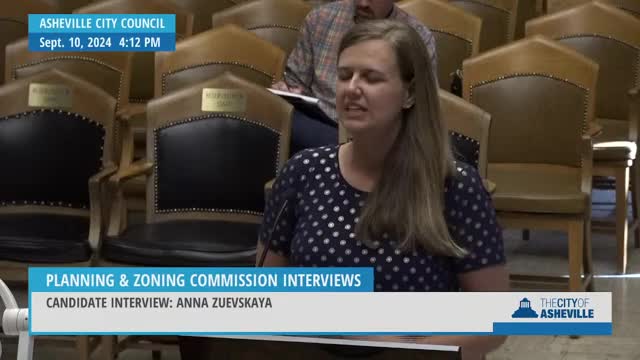Housing Crisis Deepens as Prices and Interest Rates Surge
September 13, 2024 | Asheville City, Buncombe County, North Carolina
This article was created by AI summarizing key points discussed. AI makes mistakes, so for full details and context, please refer to the video of the full meeting. Please report any errors so we can fix them. Report an error »

In a recent government meeting, officials discussed the pressing challenges facing Asheville's housing market, particularly the impact of rising property prices and interest rates on local residents. The influx of newcomers, drawn by the area's appeal as a retirement destination and its relatively lower housing costs compared to cities like New York, has exacerbated the situation. While these new residents may find it easier to purchase homes, long-term residents are feeling the strain of increased property taxes, which can be devastating for those on fixed incomes.
The conversation highlighted the dual pressures of external market forces and internal community dynamics, with many low-income residents being pushed out of their neighborhoods. The rising interest rates have further complicated the landscape, making housing less affordable for all income levels, particularly the most vulnerable.
Officials also addressed the historical context of Asheville's urban development, acknowledging the legacy of urban renewal that has disproportionately affected Black communities and local businesses. In response, they emphasized the importance of engaging with impacted neighborhoods through planning and zoning initiatives aimed at healing and repair.
One proposed strategy is the implementation of community benefits agreements, which would ensure that the profits from new developments benefit those who have been historically displaced. However, the feasibility of such agreements remains uncertain, and officials are keen to explore how these tools can be effectively utilized in North Carolina.
Additionally, the discussion touched on the potential of land trusts as a means to provide affordable housing. However, challenges remain, particularly regarding funding. Comparisons were made to successful models in other cities, such as Houston, which have benefited from substantial initial investments that have allowed for greater inventory and support for affordable housing initiatives.
As Asheville grapples with these complex issues, the need for innovative solutions and community engagement remains critical to ensuring that the city can accommodate both new residents and long-standing community members.
The conversation highlighted the dual pressures of external market forces and internal community dynamics, with many low-income residents being pushed out of their neighborhoods. The rising interest rates have further complicated the landscape, making housing less affordable for all income levels, particularly the most vulnerable.
Officials also addressed the historical context of Asheville's urban development, acknowledging the legacy of urban renewal that has disproportionately affected Black communities and local businesses. In response, they emphasized the importance of engaging with impacted neighborhoods through planning and zoning initiatives aimed at healing and repair.
One proposed strategy is the implementation of community benefits agreements, which would ensure that the profits from new developments benefit those who have been historically displaced. However, the feasibility of such agreements remains uncertain, and officials are keen to explore how these tools can be effectively utilized in North Carolina.
Additionally, the discussion touched on the potential of land trusts as a means to provide affordable housing. However, challenges remain, particularly regarding funding. Comparisons were made to successful models in other cities, such as Houston, which have benefited from substantial initial investments that have allowed for greater inventory and support for affordable housing initiatives.
As Asheville grapples with these complex issues, the need for innovative solutions and community engagement remains critical to ensuring that the city can accommodate both new residents and long-standing community members.
View full meeting
This article is based on a recent meeting—watch the full video and explore the complete transcript for deeper insights into the discussion.
View full meeting
